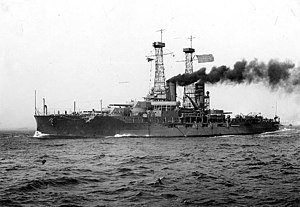USS North Dakota (BB-29)

North Dakota underway, circa 1912
|
|
| History | |
|---|---|
|
|
|
| Name: | North Dakota |
| Namesake: | State of North Dakota |
| Ordered: | 2 March 1907 |
| Builder: | Fore River Shipyard |
| Laid down: | 16 December 1907 |
| Launched: | 10 November 1908 |
| Sponsored by: | Mary Benton |
| Commissioned: | 11 April 1910 |
| Decommissioned: | 22 November 1923 |
| Struck: | 7 January 1931 |
| Identification: | Hull symbol:BB-29 |
| Fate: | Sold for scrap 16 March 1931 |
| General characteristics | |
| Class and type: | Delaware-class battleship |
| Displacement: | |
| Length: | |
| Beam: | 85 ft 3 in (26 m) |
| Draft: |
|
| Installed power: |
|
| Propulsion: | |
| Speed: | 21 kn (24 mph; 39 km/h) |
| Range: | 6,500 nmi (12,000 km; 7,500 mi) @ 12 kn (14 mph; 22 km/h) |
| Crew: | 933 officers and men |
| Armament: | |
| Armor: | |
USS North Dakota (BB-29) was a dreadnought battleship of the United States Navy, the second member of the Delaware class, her only sister ship being Delaware. North Dakota was laid down at the Fore River Shipyard in December 1907, was launched in November 1908, and commissioned into the US Navy in April 1910. She was armed with a main battery of ten 12-inch (305 mm) guns and was capable of a top speed of 21 kn (24 mph; 39 km/h). North Dakota was the first vessel of the US Navy to be named after the 39th state.
North Dakota had a peaceful career; she was present during the United States occupation of Veracruz in 1914, but did not see action. After the United States entered World War I in April 1917, North Dakota remained in the US, training crewmen for the rapidly expanding wartime Navy, and therefore did not see combat. She remained on active duty through the early 1920s, until she was decommissioned under the terms of the Washington Naval Treaty in November 1923, and subsequently converted into a radio-controlled target ship. She served in that capacity until 1930, when she was replaced in that role by Utah. In 1931, she was sold for scrapping and thereafter dismantled.
North Dakota was 518 ft 9 in (158 m) long overall and had a beam of 85 ft 3 in (26 m) and a draft of 27 ft 3 in (8 m). She displaced 20,380 long tons (20,707 t) as designed and up to 22,400 long tons (22,759 t) at full combat load. The ship was powered by two-shaft Curtis steam turbines and fourteen coal-fired Babcock & Wilcox boilers, generating a top speed of 21 knots. The ship had a cruising range of 6,500 nautical miles (12,000 km; 7,500 mi) at a speed of 12 kn (14 mph; 22 km/h). She had a crew of 933 officers and men. Her bow had an early example of bulbous forefoot.
...
Wikipedia
